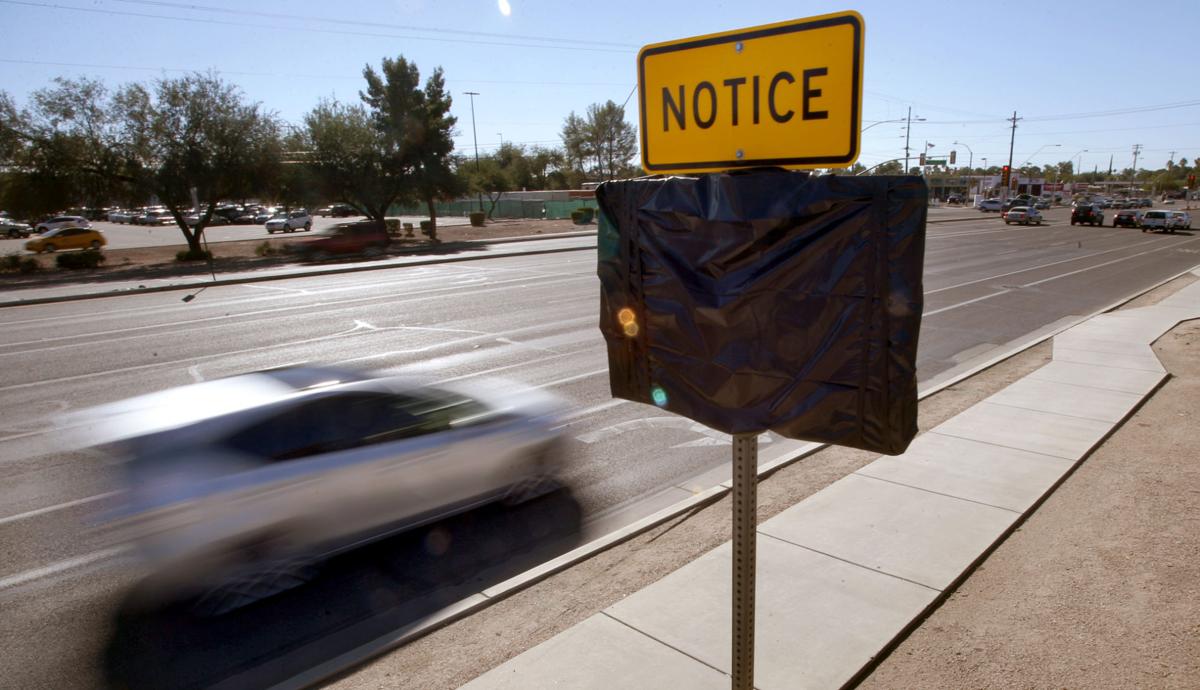Tucsonans spoke loudly on the question of photo radar enforcement — at least those who bothered to vote did.
In the city limits, there are about 400,000 eligible voters, 226,800 registered voters and 80,500 people who actually voted. Thanks to the 21 percent of you who have the right to vote and took the opportunity to do so on Nov 3.
But that’s another issue — elections are decided by those who vote, and in this city, voters said “no more” to photo radar enforcement, which includes mobile radar vans and red-light cameras.
Communities across the country have made similar decisions on automated traffic enforcement, often against the warnings of law enforcement, which argues that the cameras reduce accidents.
“The statistics we presented showed a definite decrease at the intersections included,” said Tucson Police Chief Roberto Villaseñor.
The Police Department’s 2014 annual report showed the yearly number of collisions at all eight of the intersections with photo enforcement went from nearly 200 prior to beginning the program in 2007 to around 50 last year.
The most dramatic decline was realized at the congested intersection of Tanque Verde/Grant/Kolb roads, where prior to installing cameras there were 40 collisions per year, but afterward the number dropped to about five in 2014.
“I’m concerned the numbers are going to go back up,” said City Councilwoman Regina Romero.
Romero said she was convinced the photo enforcement program added to public safety on the roads.
Police aren’t the only ones likely to be lamenting decisions to abandon automated enforcement programs.
American Traffic Solutions, the company the city contracted with to run the photo-radar program, made about $1.2 million on the Tucson program last year.
Road Runner contacted ATS for an interview, but did not receive a response.
While the loss of Tucson isn’t exactly going to put ATS out of business, it has at least 300 other customers across the U.S. and Canada, according to the company website, but the recent vote here shows something of a trend.
About 40 cities and towns have banned the use of automated enforcement and at least 26 states either don’t use photo radar programs or have laws forbidding them, according to the Insurance Institute for Highway Safety.
Programs remain in place, however, in nearly 440 jurisdictions across the country.
But the trend still can’t be good for the bottom lines of companies like ATS, which make a living providing these services.
And it speaks to a general unease that many people have with the perception of government surveillance, whether that’s cataloging cell phone data, monitoring online habits or snapping photos of red-light runners.
The folks behind the campaign to end automated red-light and speed enforcement in the city said there was an issue of fairness.
That’s a sentiment City Councilman Steve Kozachik shared.
“We owe it to the public to redefine the intersections,” he said.
Unlike many places, the intersection of a street in Tucson doesn’t begin at the painted line where drivers are expected to stop on red. Rather, it’s a sometimes-unmarked line that runs from corner to corner.
In larger intersections like the one at East Speedway and North Kolb Road, that can be as much as 50 feet past the marked line on the street.
Kozachik said this leaves drivers confused as to where they should stop if caught between amber and red traffic signals: Stop beyond the marked line and your car could block the crosswalk or intersection, continue through and you risk getting a citation in the mail.
“If we had done that, it probably wouldn’t have been on the ballot,” Kozachik said.
Villaseñor said his department respects the wishes of voters and understands their frustration.
To prove that, Villaseñor had all the cameras deactivated immediately following the election.
Technically, he said, the cameras could have kept snapping photos and issuing citations until the City Council accepts a final election canvass this week.
“In my view, that would have been unethical,” Villaseñor said.
Now, only time will tell how the community’s decision weigh against public safety.
Down the road
Motorists traveling east on Interstate 10 between Tucson and Benson can expect travel restrictions Monday, Nov. 16.
The Arizona Department of Transportation plans to resume paving operations east of Marsh Station Road. Drivers should plan for delays with the interstate narrowed to one travel lane in the area.
In an effort to minimize delays, ADOT crews will begin paving on eastbound I-10 between mileposts 292 and 296 at 12:30 a.m. Monday and finish by 4 p.m. that day.
The work is part of a $15 million project that includes repaving 17 miles of I-10 and replacing the westbound I-10 bridge over Davidson Canyon, located at milepost 285 about 20 miles east of Tucson.
The city of Tucson plans an open house for the Kolb Road to Sabino Canyon Road connection project.
The meeting is planned for Thursday, Nov.19, from 5:30 to 7 p.m. at the Morris K. Udall Regional Center, 7200 E. Tanque Verde Road.
The purpose of the meeting is to introduce the contractor, provide information and answer questions about the construction.
The improvements include a four-lane roadway with bike lanes and sidewalks extending Sabino Canyon Road south from Tanque Verde Road to connect with Kolb north of Speedway.
Construction is scheduled to begin in December and last about 15 months.
For additional information, contact Lori Lantz at lori@gordleygroup.com or 327-6077.





